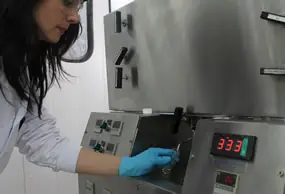Given the inherent advantages of this technology, it’s evident to see the high potential of supercritical fluids in the food sector. Among its applications for the industry are extractive processes, fractionation processes, or processes for the removal of unwanted compounds (dearomatization and decontamination). Below, we summarise the most significant ones.
Advantages associated with supercritical carbon dioxide treatment processes for food processing
Food product manufacturing typically involves a separation stage to recover the components of interest from a complex mixture in which they are present. At times, separation treatments are required to eliminate compounds that are not desired in the food, such as fatty compounds or contaminants like pesticides.
Many times, these separation stages use organic solvents. However, due to the associated handling inconveniences, legislation is progressively limiting their use in food processing, as well as the maximum tolerable thresholds in the final products.
Furthermore, extraction using organic solvents often involves high temperatures, which can degrade certain active ingredients. It also requires subsequent conditioning and purification stages of the extracts obtained or the treated material to remove residues of the solvent used.
Given these considerations, the application of supercritical carbon dioxide can be a suitable alternative due to advantages such as its high availability, low cost, non-toxicity, non-flammability, or non-explosiveness. Both the extract and the starting matrix are free from solvent residues, and the process avoids severe temperature conditions.
Types of food applications and examples
Given the aforementioned inherent advantages, it’s evident to recognize the high potential of supercritical fluids in the food sector. Among its applications for the sector are extractive processes, fractionation processes, or processes for the removal of unwanted compounds (dearomatization and decontamination).
Examples of food applications, some of which will be discussed in depth later in this blog, would include the following batch extraction processes:
- Decaffeination of coffee and tea: Through this process, the extracted caffeine is also recovered in an aqueous solution, which can then be concentrated and separated. This solution is available as a product for other food, pharmaceutical, or cosmetic applications. In this way, up to 99% of the caffeine is selectively extracted, avoiding significant loss of aroma.
- Fat removal from foods, such as cocoa fat removal: Supercritical carbon dioxide is capable of extracting fat from cocoa to levels below 0.5%. This results in both defatted cocoa as treated raw material and cocoa butter as an extract. Other examples include fat removal from nuts and fat removal from cereals.
- Obtaining herbal extracts and aromatic extracts: Due to its high selectivity, companies like FLAVEX NATUREXTACTE (Germany) have been manufacturing botanical extracts for over 25 years, with an annual production exceeding 1000 tonnes. Supercritical extracts of ginger, marigold, carrot, olive, and pepper are some examples of products currently commercialized.
- Removal of contaminants from foods: Removing pesticides from rice is one of the examples of this type of process, currently implemented on an industrial scale. For instance, there is a plant located in Taiwan with a treatment capacity of 90 tonnes of rice per day (Brunner G. 2010).
- Obtaining hop extract for beer brewing: Supercritical extraction enables the production of a high-quality extract used to provide proper aroma to the beer.
In addition to the aforementioned processes applied to solid matrices, the use of supercritical carbon dioxide for the fractionation of liquid substances working in countercurrent is also another important field of food application. It is employed for processes such as the fractionation of omega-3 fatty acids (for example, from fish oils), enrichment of tocopherols, or dealcoholization of beverages such as wine, beer, or cider. delving into the latter type of processes, several studies demonstrate the viability of supercritical carbon dioxide for reducing alcohol content in beverages to levels below 0.5%, without using high temperatures, and enabling the recovery of aromatic substances co-extracted with ethanol, thus minimizing the organoleptic impact associated with dealcoholization treatment (Brunner G. 2004).
Due to its selectivity as a solvent medium, other applications of the technology include fat removal from foods for the production of, for example, dietary products, or cholesterol-free products, and the deodorization of food-use matrices such as rosemary or valerian.
Other non-extractive processes have been developed in recent years using supercritical fluid technology. With applications in the field of food, processes such as substance impregnation (such as vegetable matrices, packaging materials) or substance microencapsulation are worth mentioning. The aim is to obtain improvements in their handling, dosing, storage, or preservation, among others.
Concrete industrial applications present in our daily lives
Given the advantages mentioned earlier, supercritical fluid technology has wide-ranging industrial applications within the food sector, some of which have already been discussed, and is currently implemented in various common products. In fact, several of the previously described applications are currently carried out at the AINIA industrial plant, a pioneering multi-product plant for the contract manufacturing of supercritical processes, serving companies.
To grasp the extent of technology implementation, consider the example included in a publication by Gerd Brunner (one of the most important researchers in the field of Supercritical Fluids), illustrating how a daily menu can include foods where supercritical fluid technology has played a significant role in their processing. It’s just a matter of continuing to identify those products for which the technique represents a real qualitative leap.




